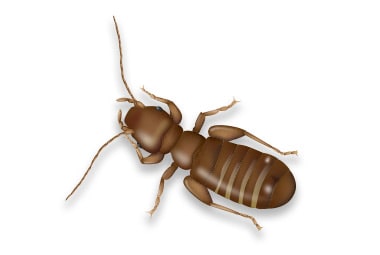
Booklice are found living throughout the entire world, in the United States alone there are about 287 species. Despite their name booklice, or bark lice, as they are commonly referred to, are not true lice because they only feed on fungi or mold. They are referred to as lice only because of their similar appearance to true lice species
| Pest Identification | |
|---|---|
| Recognition | Adult booklice range in color from translucent white to gray or brown. Booklice may be winged (mostly found living outdoors) or wingless (found living indoors) depending on their species. Adults are very small with most only growing to be less 1/16th – 1/8th of an inch in length. Booklice have soft bodies and chewing mouthparts. Their back legs are thicker and stronger appearing than their other four but they cannot jump. Instead of jumping, they run very quickly. Nymphs look like the adults except smaller and are always wingless. |
| Biology | The life cycle of the booklice is weather dependent. The warmer the temperature, than the faster it will occur. With favorable temperatures the entire life cycle can take less than one month, with cooler temperatures it can take up to three months. The female deposits her eggs (about 60) one at a time covering each over with some soil or debris. Once the nymphs hatch they then go through four nymph stages, until they become a sexually mature adult. |
| Habits | Booklice are found living in areas with high relative humidity, because a high humidity environment easily produces their main food sources of fungi and mold. Booklice will migrate in large numbers to locate a high humidity environment. If the correct environment cannot be found they often will die off. In a home or other buildings, book lice can often be found invading things and areas that include: -Basements -Attics -Storage trunks -Cardboard storage boxes -Damp books or other papers -Wallpaper -Closets -Areas around drains -In stored foods like flour and cereals. |
| Prevention | Making some environmental changes and having a professional pest control plan in place may accomplish the prevention of booklice around your home. The best way to control booklice entering your home is to lower the relative humidity within it, especially in storage areas like closets, attics, crawl spaces and basements. Lowering your home’s humidity levels can be achieved with the use of de-humidifiers, increasing ventilation, and installing air conditioners. |
| Professional | If booklice have overtaken your home than professional control may be required. The technicians at Rottler will inject insecticide aerosol and dust formulations into structural voids where booklice are breeding in damp, moldy situations. A residual insecticide will be applied as an exterior perimeter (barrier) treatment around the foundation as well. |

